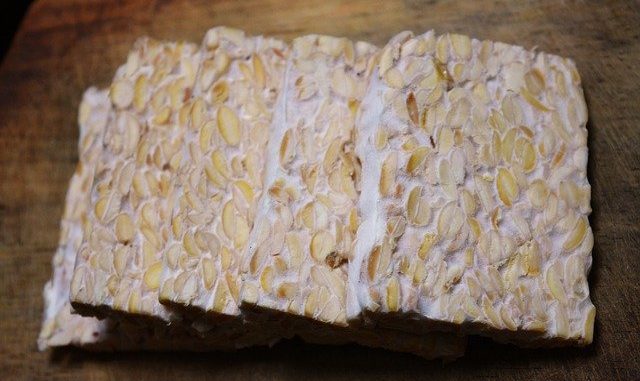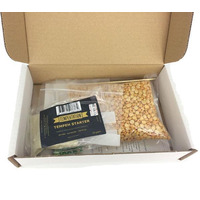
Tempeh (Tempe) is a traditional soy food produced in Indonesia. It has a very high protein content which makes it an ideal substitute for meat in vegetarian and vegan dishes.
If you are interested in meatless burgers then this is the ideal ingredient. It is usually sold as a block which is then sliced. Tempeh fermentation kits are now available for all those wanting to produce their own. It seems a lot of fun and fits with the current view on home production.
What Is Tempeh?
Tempeh is prepared by fermenting cooked soybeans wrapped in wilted banana leaves or in plastic. It relies on mold such as Rhizopus oligosporus whose mycelia penetrate blocks of soybean. Manufacture is simple and low cost.
Tempeh is becoming an acceptable food for use by vegetarians in Western culture.
Production Of Tempeh
We often think that soybeans only are used in making tempeh but it can also be prepared from other legumes. Many different flavours have been created using beans and other pulses such as black beans, from peas, especially black-eyed peas and of course chickpeas.
Grains also lend themselves well to this type of mold fermentation. We have seen tempeh prepared from rice, especially brown rice, barley, millet and even sorghum. Different textures are created by adding seeds such as sunflower, flax and sesame seeds.
Whole soybeans are cleaned and rehydrated in hot water at 93 Centigrade for 10 minutes. Following dehulling, the beans are soaked in water to which lactic acid is added overnight. The soybeans are then boiled for 68 minutes. These are drained and cooled to 38ºC. The beans are then inoculated with Rhizopus oligosporus. The whole mix is incubated on trays between temperatures of 35 and 38ºC at a relative humidity of between 75 and 78 percent for over 18 hours. The tempeh block is allowed to dehydrate and then wrapped in leaves or plastic.
The fermentation process produces a solid cake which is bound together by the mould mycelium. The tempeh has a white mycelial surface which sometimes has yellow spots or black spores.
The block can be cut into blocks without disintegrating.
The Flavour Of Tempeh
The flavour is of bean. This means it has a green, sometimes slight woody and nutty note which is close to mushroom. Given that it is a mould, the flavour can also lend an umami note as a replacement to other fungi.
Using Tempeh
Tempeh is usually used instead of tofu in recipes which are conventionally stir-frys, but also in casseroles, stews and curry. It holds its texture extremely well when it is conventionally fried too.
If you are pan-frying, simply heat 1 tbsp of vegetable oil in a pan and fry for around 5 minutes. Keep turning regularly to produce a golden brown colour which makes it extremely appealing.
The other way is to oven bake it. Again, coat with vegetable oil and then bake in an oven tray for between 20 and 25 minutes at 180°C.
It has in recent years developed its own cuisine where meat, particularly mince and ground beef, can be replaced.
Try chopping and grating it. It lends itself well to vegan stews, casseroles and chili.
When cooking with cubes, slices and slabs, use its firm texture but to preserve this with any type of recipe, make sure the thickness is at least 1cm (near enough to 3/4 inch).
A number of recipe books are available now which cover ways to cook with tempeh as well as tofu. John Stone has put together quite a range of recipes in his book “Tofu and Tempeh Cookbook: Easy and Healthy Tofu and Tempeh Recipes“.
Nutritional Profile
Tempeh has a simple nutritional profile:-
A 1-cup serving of tempeh contains:
- 319 calories
- 34 g protein
- 18 g fat with 1 g of that being saturated fat
- 13 g carbohydrates
- 10 g fibre (fiber)
- 184 mg calcium
- 4.5 mg iron
- 134 mg magnesium
- 684 mg potassium
- per 100g
- 183 calories or 763kJ
- 22 g protein
- 8 g fat but NO saturated fat
- 5 g carbohydrates of which there are zero sugars
- 6.5 g fibre (fiber)
- 105 mg calcium
- 2.56 mg iron
- 76.4 mg magnesium
- 390 mg potassium
Tempeh has a very protein content as we can see from the USDA’s database. It is also a good source of calcium.
Products Using Tempeh
Please note this article contains links to our affiliate marketing partners. Please read our affiliate disclosure.
Starter kits are available for anyone who is really keen to produce their own. Tempehtation based in Scotland started producing kits for all of us wanting to produce our own delicious and tempting tempeh. It’s a clever idea because it fits with the make-your-own category.
Tempehtation have filmed a handy tempeh making tutorial here! https://www.youtube.com/watch?v=Zy7yLJ4ZzNI
The kit contains all you need to delve into the world of producing your own. It contains:
- Instructions for yellow split peas tempeh
- 400g of yellow split peas
- 20g of tempeh starter
- Reusable plastic bag
- Satay stick
If you are keen on buying the ready-made food then look no further than the Tiba Tempeh store. True to their ethos they offer organic products. They deliver not just traditional blocks but also jars and pastes. The web-site has some really valuable and tempting recipes to encourage you to make the most of this ingredient.

The range of ready produced foods is also an eye opener. Here is a sense of its versatility:-
- curry-spiced pieces
- sweet chilli pieces
- soy-marinated pieces
- smoky BBQ burgers.
All these are available as a selection in a pack of 4.
References
Liu, K.S. (1997) Soybean: chemistry, technology and utilization. Chapman & Hall, New York.
Revised: Addition of new material to original post of 16th May 2018.

Leave a Reply